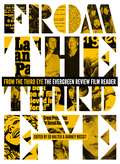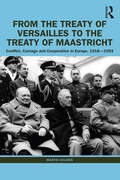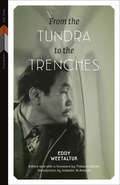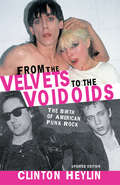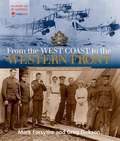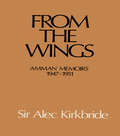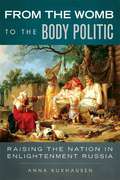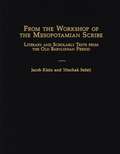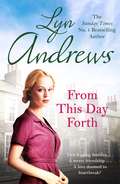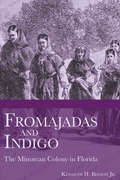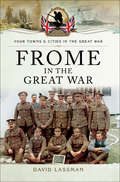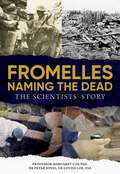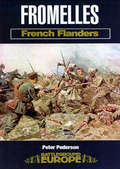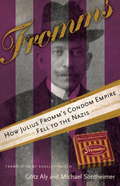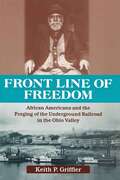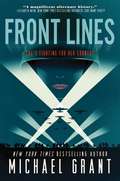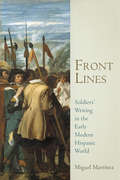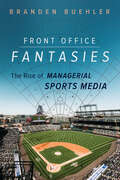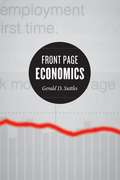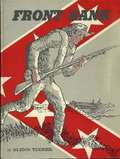- Table View
- List View
From the Third Eye: The Evergreen Review Film Reader
by Ed Halter Barney RossetIn this first collection of film writing from Evergreen Review, the legendary publication's important contributions to film culture are available in a single volume. Featuring such legendary writers as Nat Hentoff, Norman Mailer, Parker Tyler, and Amos Vogel, the book presents writing on the films of Jean-Luc Godard, Pier Paolo Pasolini, Ousmane Sembene, Andy Warhol, and others and offers incisive essays and interviews from the late 1950s to early 1970s. Articles explore politics, revolution, and the cinema; underground and experimental film, pornography, and censorship; and the rise of independent film against the dominance of Hollywood. A new introductory essay by Ed Halter reveals the important role Evergreen Review and its publisher, Grove Press, played in advancing cinema during this period through innovations in production, distribution, and exhibition. Editor Ed Halter began working on this book in 2001 with Barney Rosset, using his personal files and interviews with him as initial research.From the Trade Paperback edition.
From the Treaty of Versailles to the Treaty of Maastricht: Conflict, Carnage And Cooperation In Europe, 1918 – 1993
by Martin HolmesThis book examines European history and politics between two very well-known but flawed treaties: The Treaty of Versailles and the Treaty of Maastricht. Taking the Treaty of Versailles, signed following World War I, as a starting point, the volume argues that while it was well-intentioned to the point of being utopian, it was also totally impractical, rearranging the map of Europe in a way which led to the tragic descent into conflict and barbarism in World War II. The volume then moves through the post war period, the outcome of the war producing the uneasy stability of a Cold War divided continent, and with the establishment of NATO in 1949, the process of European integration ushered in the era of cooperation. Under the influence of Charles de Gaulle, the newly created European Community acted as an association of sovereign states led by France and Germany, spurring economic growth and encouraging other countries to apply to join. After de Gaulle’s retirement in 1969, this approach was progressively abandoned in favour of a federal model of integration in which member states transferred their sovereignty to the institutions of what became the European Union. Europe was to be transformed from a continent to a country. The book concludes by analysing the Maastricht treaty, which enshrined this process, as being as fatally flawed as the Versailles Treaty and charts the post-Maastricht slow decline of the European Union giving way to widespread Euroscepticism. From the Treaty of Versailles to the Treaty of Maastricht will appeal to researchers and students alike interested in European history, politics and World War I and II.
From the Tundra to the Trenches
by Thibault Martin Eddy Weetaltuk Isabelle St. Amand“My name is Weetaltuk; Eddy Weetaltuk. My Eskimo tag name is E9-422.” So begins From the "Tundra to the Trenches." Weetaltuk means “innocent eyes” in Inuktitut, but to the Canadian government, he was known as E9-422: E for Eskimo, 9 for his community, 422 to identify Eddy. In 1951, Eddy decided to leave James Bay. Because Inuit weren’t allowed to leave the North, he changed his name and used this new identity to enlist in the Canadian Forces: Edward Weetaltuk, E9-422, became Eddy Vital, SC-17515, and headed off to fight in the Korean War. In 1967, after fifteen years in the Canadian Forces, Eddy returned home. He worked with Inuit youth struggling with drug and alcohol addiction, and, in 1974, started writing his life’s story. This compelling memoir traces an Inuk’s experiences of world travel and military service. Looking back on his life, Weetaltuk wanted to show young Inuit that they can do and be what they choose. From the Tundra to the Trenches is the fourth book in the First Voices, First Texts series, which publishes lost or underappreciated texts by Indigenous writers. This new English edition of Eddy Weetaltuk’s memoir includes a foreword and appendix by Thibault Martin and an introduction by Isabelle St-Amand.
From the Velvets to the Voidoids: The Birth of American Punk Rock
by Clinton HeylinExhaustively researched and packed with unique insights, this history journeys from the punk scene's roots in the mid-1960s to the arrival of "new wave" in the early 1980s. With a cast that includes Patti Smith, Pere Ubu, Television, Blondie, the Ramones, the MC5, the Stooges, Talking Heads, and the Dead Boys, this account is the definitive story of early American punk rock. Extraordinarily balanced, it tells the story of the music's development largely through the artists' own words, while thoroughly analyzing and evaluating the music in a lucid and cogent manner. First published in 1993, this was the first book to tell the stories of these then-little-known bands; now, this edition has been updated with a new discography, including imports and bootlegs, and an afterword detailing the post-1970s history of these bands. Filled with insights from interviews with artists such as Lou Reed, Debbie Harry, David Byrne, Patti Smith, and Richard Hell, this book has long been considered one of the essential reads on rock rebellion.
From the Vilna Ghetto to Nuremberg: Memoir and Testimony
by Abraham SutzkeverIn 1944, the Yiddish poet Abraham Sutzkever was airlifted to Moscow from the forest where he had spent the winter among partisan fighters. There he was encouraged by Ilya Ehrenburg, the most famous Soviet Jewish writer of his day, to write a memoir of his two years in the Vilna Ghetto. Now, seventy-five years after it appeared in Yiddish in 1946, Justin Cammy provides a full English translation of one of the earliest published memoirs of the destruction of the city known throughout the Jewish world as the Jerusalem of Lithuania.Based on his own experiences, his conversations with survivors, and his consultation with materials hidden in the ghetto and recovered after the liberation of his hometown, Sutzkever’s memoir rests at the intersection of postwar Holocaust literature and history. He grappled with the responsibility to produce a document that would indict the perpetrators and provide an account of both the horrors and the resilience of Jewish life under Nazi rule. Cammy bases his translation on the two extant versions of the full text of the memoir and includes Sutzkever’s diary notes and full testimony at the Nuremberg Trials in 1946. Fascinating reminiscences of leading Soviet Yiddish cultural figures Sutzkever encountered during his time in Moscow – Ehrenburg, Yiddish modernist poet Peretz Markish, and director of the State Yiddish Theatre Shloyme Mikhoels – reveal the constraints of the political environment in which the memoir was composed.Both shocking and moving in its intensity, From the Vilna Ghetto to Nuremberg returns readers to a moment when the scale of the Holocaust was first coming into focus, through the eyes of one survivor who attempted to make sense of daily life, resistance, and death in the ghetto.A Yiddish Book Center Translation
From the War on Poverty to the War on Crime: The Making of Mass Incarceration in America
by Elizabeth HintonHow did the land of the free become the home of the world's largest prison system? Elizabeth Hinton traces the rise of mass incarceration to an ironic source: not the War on Drugs of the Reagan administration but the War on Crime that began during Johnson's Great Society at the height of the civil rights era.
From the West Coast to the Western Front
by Greg Dickson Mark ForsytheIt has often been observed that the First World War jolted Canada into nationhood, and as Mark Forsythe and Greg Dickson show in this compelling book, no province participated more eagerly in that transformation or felt the aftershock more harshly than British Columbia. In From the West Coast to the Western Front, Forsythe, host of CBC Radio's mid-day show BC Almanac, marks the 100th anniversary of World War I by teaming with historian Greg Dickson and the ever resourceful BC Almanac audience to compile a sweeping portrayal of that crucial chapter of BC history.Of the 611,000 Canadians who fought for King and Country,55,570 were from British Columbia-the highest per capita rate of enlistment in the country. Of that contingent, 6,225 died in battle, a critical loss to a fledgling province of barely 400,000.Compiling stories, artifacts and photos sent in by BC Almanac listeners from across the province, this volume tells of submarine smuggling, bagpipes lost on the battlefield and of the ongoing struggles by soldiers who made it home. It tells of battles that set records for mass death amid conditions of unequalled squalor, but also of the heroism of front-line nurses and soldiers like George Maclean, a First Nations man from the Okanagan, who won the Distinguished Conduct Medal.By turns devastating, harrowing, insightful and miraculous, these stories reveal much about the spirit and resilience of a people who survived one of history's greatest disasters to build the province we have today.
From the Wings: Amman Memoirs 1947-1951
by Alec KirkbrideFirst Published in 1976. Routledge is an imprint of Taylor & Francis, an informa company.
From the Womb to the Body Politic: Raising the Nation in Enlightenment Russia
by Anna KuxhausenIn Russia during the second half of the eighteenth century, a public conversation emerged that altered perceptions of pregnancy, birth, and early childhood. Children began to be viewed as a national resource, and childbirth heralded new members of the body politic. The exclusively female world of mothers, midwives, and nannies came under the scrutiny of male physicians, state institutions, a host of zealous reformers, and even Empress Catherine the Great. Making innovative use of obstetrical manuals,belles lettres, children's primers, and other primary documents from the era, Anna Kuxhausen draws together many discourses-medical, pedagogical, and political-to show the scope and audacity of new notions about childrearing. Reformers aimed to teach women to care for the bodies of pregnant mothers, infants, and children according to medical standards of the Enlightenment. Kuxhausen reveals both their optimism and their sometimes fatal blind spots in matters of implementation. In examining the implication of women in public, even political, roles as agents of state-building and the civilizing process,From the Womb to the Body Politicoffers a nuanced, expanded view of the Enlightenment in Russia and the ways in which Russians imagined their nation while constructing notions of childhood.
From the Workshop of the Mesopotamian Scribe: Literary and Scholarly Texts from the Old Babylonian Period (Publications of the Association of Ancient Historians #12)
by Jacob Klein Yitschak SefatiThis volume presents first editions of a variety of cuneiform tablets from the Old Babylonian period belonging to the collection of the late Shlomo Moussaieff. It makes available for the first time three texts representing varying levels of Mesopotamian scribal education. The first is what the authors argue is the most complete copy of the first fifty lines of the standard version of the Sumerian epic Gilgameš and the Bull of Heaven. The second is a hitherto unpublished bilingual (Sumerian-Akkadian) lexical list of unknown provenance, similar to the Proto-Aa syllabary. Each of the 314 entries preserved on this tablet provides a pronunciation gloss, a Sumerian logogram, and an Akkadian translation. A unique feature of this list is that the signs are arranged on the basis of graphic concatenation: each sign contains one of the graphic components of the preceding sign. It also yields a great number of hitherto unknown, synonymous Akkadian translations to the Sumerian logograms. The final chapter contains an edition of two groups of lenticular school tablets, containing thirty-three elementary-level scribal exercises.With this volume, Jacob Klein and Yitschak Sefati preserve and disseminate important artifacts that advance the study of Sumerian literature, Mesopotamian lexicography, and ancient Near Eastern scribal education.
From this Day Forth: Can true love hope to triumph?
by Lyn AndrewsTwo feuding families. A secret friendship. A love doomed to heartbreak? In her gripping saga From This Day Forth, Lyn Andrews writes an engrossing tale of a family feud threatening the happiness of the younger generations. Perfect for fans of Anne Baker, Katie Flynn and Sheila Newberry.Celia and Lizzie are the best of friends. But their families, the Miltons and the Slatterys, are the worst of enemies, divided by religion and by status. So their friendship is a carefully guarded secret, for if Celia's father Charlie ever heard of it he would beat her to within an inch of her life.Then one day the unthinkable happens. Joe Slattery, Lizzie's brother, does a good turn for the Milton family and rescues their youngest from a grievous accident. From that day forth, Celia Milton just can't get Joe out of her mind. And, despite himself, Joe Slattery is increasingly drawn to Celia and to a love that seems doomed to heartbreak - unless they can find a way around the prejudice of generations and the terrifying bigotry of Charlie Milton... What readers are saying about From This Day Forth: 'I thoroughly enjoyed this book and finished it in two days. I have read Lyn Andrews books before and have always found them gripping... This story is one you can really lose yourself in' 'Great story - five stars'
From this Day Forth: Can true love hope to triumph?
by Lyn AndrewsTwo feuding families. A secret friendship. A love doomed to heartbreak? In her gripping saga From This Day Forth, Lyn Andrews writes an engrossing tale of a family feud threatening the happiness of the younger generations. Perfect for fans of Anne Baker, Katie Flynn and Sheila Newberry.Celia and Lizzie are the best of friends. But their families, the Miltons and the Slatterys, are the worst of enemies, divided by religion and by status. So their friendship is a carefully guarded secret, for if Celia's father Charlie ever heard of it he would beat her to within an inch of her life.Then one day the unthinkable happens. Joe Slattery, Lizzie's brother, does a good turn for the Milton family and rescues their youngest from a grievous accident. From that day forth, Celia Milton just can't get Joe out of her mind. And, despite himself, Joe Slattery is increasingly drawn to Celia and to a love that seems doomed to heartbreak - unless they can find a way around the prejudice of generations and the terrifying bigotry of Charlie Milton...What readers are saying about From This Day Forth: 'I thoroughly enjoyed this book and finished it in two days. I have read Lyn Andrews books before and have always found them gripping... This story is one you can really lose yourself in' 'Great story - five stars'
Fromajadas and Indigo: The Minorcan Colony in Florida
by Kenneth H. Beeson Jr.With great anticipation, more than twelve hundred settlers the majority from the Mediterranean island of Minorca arrived on the eastern shore of Florida, south of St. Augustine, in 1768 to begin a new life at the colony of New Smyrna. Despite the initial successes of the colony, political strife and inadequate financing steered the colonists into dire straights. Fleeing the miserable living conditions and ruthless maltreatment of colony overseers, the colonists eventually sought refuge in St. Augustine, where the governor granted them asylum in 1777.For more than two hundred years the descendants of the surviving colonists have formed a resourceful and talented portion of St. Augustine's population. From the six hundred plus that made the walk from New Smyrna, there are now over fifteen thousand descendants living in the St. Augustine area today. This book reveals the history of these fascinating people for the first time.
Frome in the Great War (Your Towns & Cities in the Great War)
by David LassmanThe Somerset town of Frome is something of a paradox. Since being founded at the end of the sixth century its fiercely independent nature has been unchanging. A nature which, as one columnist has noted: 'seems to have revolved around the eminently sensible attitude of To hell with national events! We will stay as we are.' And yet a century ago, when called on by its country to do its duty in the Great War, it rose to the task admirably. Men from Frome and the surrounding area experienced action in all the theatres of war that the global conflict encompassed, and they took part in the numerous battles and campaigns, on land and at sea, that have become synonymous with that conflict: Ypres, Gallipoli, Jutland, the Somme. At the same time, its civilian population received a special commendation after the war for its effort throughout it. However, the towns contribution did not stop there, as many of the returning soldiers helped to create several of the national and international monuments and memorials that would pay eternal tribute to their comrades who fell on the fields of Flanders and elsewhere. Using letters, diaries, photographs, newspaper reports and eyewitness accounts, along with other archive material, local historian and author David Lassman has assembled the story of Frome during the Great War; a story which charts the transformation of this once rich and powerful textile centre and manufacturing town, along with its people, through the life-changing events of 1914 to 1918
Fromelles – Naming the Dead: The Scientists' Story
by Professor Margaret Cox Dr Peter Jones PhD Dr Louise LoeThis is the extraordinary story of the engagement between 250 young Australians, who enlisted in 1915 and died in the Battle of Fromelles of 1916, their families, and three British scientists. In 2009, the bodies of these 250 soldiers were excavated by Oxford Archaeology. Among them were the Wilson brothers who, with their comrades were subsequently reburied in individual marked graves in the new cemetery in Fromelles village. The Battle of Fromelles needs no introduction, nor do the losses sustained. Here we focus on 166 of the 250 soldiers who were excavated from six mass graves adjacent to Pheasant Wood in 2009 and who have since been identified. Each has his own story to tell as does his family. We explore aspects of these lost lives while telling the story of their recovery and identification. This is the story of how these lost soldiers were excavated and identified. It is told by the scientists who led the excavation, the anthropological and DNA analyses, and the identification process. It is their story of involvement with and commitment to this fascinating project, in which many combined decades of professional experience were pooled to help achieve a fitting final resting place, names restored, for these brave men, and belated solace for their families. Much has been written about the Battle of Fromelles, the missing soldiers, their families&’ quests to restore their identities and the discovery and excavation of the graves. This book tells a new story. it is the scientist&’s story behind naming the Fromelles&’ dead.
Fromelles: French Flanders (Battleground Europe)
by Peter PedersenHistorian Peter Pedersen examines the World War I battle on the Western Front that decimated an Australian regiment in Fromelles: French Flanders.The attack at Fromelles is significant for a number of reasons. It was the Australians’ first major operation on the Western Front and pitted them against a part of the German line that was an object lesson in the siting of a defense. Before the battle, the Australian Gallipoli veterans had airily dismissed the fighting in the new theater as “pleasant”. After it, they said grimly that Anzac was “a picnic” compared to France. Fromelles came as a terrible shock and was a foretaste of things to come. Both the genesis and aftermath of the operation were controversial. The objectives and the tactics employed to achieve them were changed several times and the sufficiency of resources vigorously debated. After the war, the British and Australian Official Historians argued as to how the battle should be interpreted. Most of the correspondence that accompanied their exchange of drafts has not been published. Peter Pedersen’s thorough account of the battle explores the genesis of the operation through the aftermath covering this monumental moment in World War I history.
Fromms
by Shelley Frisch Michael Sontheimer Gotz AlyIf you wanted to buy a top-quality condom in prewar Germany, you bought Fromms Act, the first brand name condom and still a leading brand in the German market. The man behind this "pure German quality product" was Julius Fromm, a Jewish entrepreneur who had immigrated from Russia as a child. Fromm was in the right place at the right time: he patented Fromms Act in 1916, when the combination of changing sexual mores, awareness of sexual health, and the lack of reliable prophylactics meant a market primed for his product. In 1922 he began mass production and opened international branches. Sixteen years later, after building the brand into a best seller and the company into a model business, he was forced to sell Fromms Act for a fraction of its worth to a German baroness. In 1939 he emigrated to London.Aly and Sontheimer trace Fromm's rise and fall, illuminating the ways Jewish businesses like his were Aryanized under the Nazis. Through the biography of this businessman and the story of his unusual and fabulously successful company, we learn the fascinating history of the first branded condoms in Germany and the sexual culture that allowed them to thrive, the heretofore undocumented machinations by which the Nazis robbed German-Jewish families of their businesses, and the tragedy of a man whose great love for the adopted country that first allowed him to succeed was betrayed by its government and his fellow citizens. This captivating account offers a wealth of detail and a fresh array of photographic documentation, and adds a striking new dimension to our understanding of this dark period in German history.From the Hardcover edition.
Fromms: How Julius Fromm's Condom Empire Fell to the Nazis
by Götz Aly Michael SontheimerIf you wanted to buy a top-quality condom in prewar Germany, you bought Fromms Act, the first brand name condom and still a leading brand in the German market. The man behind this “pure German quality product” was Julius Fromm, a Jewish entrepreneur who had immigrated from Russia as a child. Fromm was in the right place at the right time: he patented Fromms Act in 1916, when the combination of changing sexual mores, awareness of sexual health, and the lack of reliable prophylactics meant a market primed for his product. In 1922 he began mass production and opened international branches. Sixteen years later, after building the brand into a best seller and the company into a model business, he was forced to sell Fromms Act for a fraction of its worth to a German baroness. In 1939 he emigrated to London. Aly and Sontheimer trace Fromm’s rise and fall, illuminating the ways Jewish businesses like his were Aryanized under the Nazis. The authors also recount the Fromm family’s quest for reparations, one that came to an end only in 2006. Through the biography of this businessman and the story of his unusual and fabulously successful company, we learn the fascinating history of the first branded condoms in Germany and the sexual culture that allowed them to thrive, the heretofore undocumented machinations by which the Nazis robbed German-Jewish families of their businesses, and the tragedy of a man whose great love for the adopted country that first allowed him to succeed was betrayed by its government and his fellow citizens. This captivating account offers a wealth of detail and a fresh array of photographic documentation, and adds a striking new dimension to our understanding of this dark period in German history.
Front Line Of Freedom: African Americans And The Forging Of The Underground Railroad In The Ohio Valley (Ohio River Valley Ser.)
by Keith P. GrifflerThe Underground Railroad, an often misunderstood antebellum institution, has been viewed as a simple combination of mainly white "conductors" and black "passengers." Keith P. Griffler takes a new, battlefield-level view of the war against American slavery as he reevaluates one of its front lines: the Ohio River, the longest commercial dividing line between slavery and freedom. In shifting the focus from the much discussed white-led "stations" to the primarily black-led frontline struggle along the Ohio, Griffler reveals for the first time the crucial importance of the freedom movement in the river's port cities and towns. Front Line of Freedom fully examines America's first successful interracial freedom movement, which proved to be as much a struggle to transform the states north of the Ohio as those to its south. In a climate of racial proscription, mob violence, and white hostility, the efforts of Ohio Valley African Americans to establish and maintain communities became inextricably linked to the steady stream of fugitives crossing the region. As Griffler traces the efforts of African Americans to free themselves, Griffler provides a window into the process by which this clandestine network took shape and grew into a powerful force in antebellum America.
Front Lines
by Michael GrantPerfect for fans of The Book Thief and Code Name Verity, New York Times bestselling author Michael Grant unleashes an epic, genre-bending, and transformative new series that reimagines World War II with girl soldiers fighting on the front lines.World War II, 1942. A court decision makes women subject to the draft and eligible for service. The unproven American army is going up against the greatest fighting force ever assembled, the armed forces of Nazi Germany.Three girls sign up to fight. Rio Richlin, Frangie Marr, and Rainy Schulterman are average girls, girls with dreams and aspirations, at the start of their lives, at the start of their loves. Each has her own reasons for volunteering: Rio fights to honor her sister; Frangie needs money for her family; Rainy wants to kill Germans. For the first time they leave behind their homes and families--to go to war.These three daring young women will play their parts in the war to defeat evil and save the human race. As the fate of the world hangs in the balance, they will discover the roles that define them on the front lines. They will fight the greatest war the world has ever known.
Front Lines: Soldiers' Writing in the Early Modern Hispanic World
by Miguel MartínezIn Front Lines, Miguel Martínez documents the literary practices of imperial Spain's common soldiers. Against all odds, these Spanish soldiers produced, distributed, and consumed a remarkably innovative set of works on war that have been almost completely neglected in literary and historical scholarship. The soldiers of Italian garrisons and North African presidios, on colonial American frontiers and in the traveling military camps of northern Europe read and wrote epic poems, chronicles, ballads, pamphlets, and autobiographies--the stories of the very same wars in which they participated as rank-and-file fighters and witnesses. The vast network of agents and spaces articulated around the military institutions of an ever-expanding and struggling Spanish empire facilitated the global circulation of these textual materials, creating a soldierly republic of letters that bridged the Old and the many New Worlds of the sixteenth and seventeenth centuries.Martínez asserts that these writing soldiers played a key role in the shaping of Renaissance literary culture, which for its part gave to them the language and forms with which to question received notions of the social logic of warfare, the ethics of violence, and the legitimacy of imperial aggression. Soldierly writing often voiced criticism of established hierarchies and exploitative working conditions, forging solidarities among the troops that often led to mutiny and massive desertion. It is the perspective of these soldiers that grounds Front Lines, a cultural history of Spain's imperial wars as told by the common men who fought them.
Front Office Fantasies: The Rise of Managerial Sports Media (Studies in Sports Media)
by Branden BuehlerFront office executives have become high-profile commentators, movie and video game protagonists, and role models for a generation raised in the data-driven, financialized world of contemporary sports. Branden Buehler examines the media transformation of these once obscure management figures into esteemed experts and sporting idols. Moving from Moneyball and Football Manager to coverage of analytics gurus like Daryl Morey, Buehler shows how a fixation on managerial moves has taken hold across the entire sports media landscape. Buehler’s chapter-by-chapter look at specific media forms illustrates different facets of the managerial craze while analyzing the related effects on what fans see, hear, and play. Throughout, Buehler explores the unsettling implications of exalting the management class and its logics, in the process arguing that sports media’s managerial lionization serves as one of the clearest reflections of major material and ideological changes taking place across culture and society. Insightful and timely, Front Office Fantasies reveals how sports media moved the action from the field to the executive suite.
Front Page Economics
by Gerald D. Suttles Mark D. JacobsIn an age when pundits constantly decry overt political bias in the media, we have naturally become skeptical of the news. But the bluntness of such critiques masks the highly sophisticated ways in which the media frame important stories. In Front Page Economics, Gerald Suttles delves deep into the archives to examine coverage of two major economic crashes—in 1929 and 1987—in order to systematically break down the way newspapers normalize crises. Poring over the articles generated by the crashes—as well as the people in them, the writers who wrote them, and the cartoons that ran alongside them—Suttles uncovers dramatic changes between the ways the first and second crashes were reported. In the intervening half-century, an entire new economic language had arisen and the practice of business journalism had been completely altered. Both of these transformations, Suttles demonstrates, allowed journalists to describe the 1987 crash in a vocabulary that was normal and familiar to readers, rendering it routine. A subtle and probing look at how ideologies are packaged and transmitted to the casual newspaper reader, Front Page Economics brims with important insights that shed light on our own economically tumultuous times.
Front Page Murder (A Homefront News Mystery)
by Joyce St. AnthonyIn this World War II-era historical mystery series debut by Joyce St. Anthony, small-town editor Irene Ingram has a nose for news and an eye for clues.Irene Ingram has written for her father&’s newspaper, the Progress Herald, ever since she could grasp a pencil. Now she&’s editor in chief, which doesn&’t sit well with the men in the newsroom. But proving her journalistic bona fides is the least of Irene&’s worries when crime reporter Moe Bauer, on the heels of a hot tip, turns up dead at the foot of his cellar stairs. An accident? That&’s what Police Chief Walt Turner thinks, and Irene is inclined to agree until she finds the note Moe discreetly left on her desk. He was on to a big story, he wrote. The robbery she&’d assigned him to cover at Markowicz Hardware turned out to be something far more devious. A Jewish store owner in a small, provincial town, Sam Markowicz received a terrifying message from a stranger. Moe suspected that Sam is being threatened not only for who he is…but for what he knows. Tenacious Irene senses there&’s more to the Markowicz story, which she is all but certain led to Moe&’s murder. When she&’s not filling up column inches with the usual small-town fare—locals in uniform, victory gardens, and scrap drives—she and her best friend, scrappy secretary Peggy Reardon, search for clues. If they can find the killer, it&’ll be a scoop to stop the presses. But if they can&’t, Irene and Peggy may face an all-too-literal deadline.
Front Rank [Illustrated Edition]
by Glenn TuckerIncludes more than 20 illustrationsFamed Civil War historian Glen Tucker was commissioned by the North Carolina Confederate Centennial Commission to write a short portrait of the men and battles that the soldiers from North Carolina fought under the Stars and Bars. Illustrated beautifully throughout by Bill Ballard, the author takes the reader on to the battlefields of the Civil War and through his vivid vignettes records the immortal deeds of the North Carolinians from Manassas to the last shot at Appomattox.
